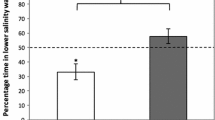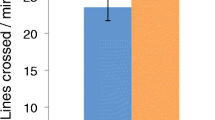Abstract
The levels of carbon dioxide (CO2) predicted for the oceans by the end of this century have recently been shown to impair olfactory discrimination in larval fishes. However, whether this disruption extends to olfactory-mediated behaviour in adult fishes is unknown. In many fishes, adult survival and reproduction can be critically dependent upon navigation to home sites. We tested the effects that near-future levels of CO2 (550, 700 or 950 ppm) have on the ability of adult five-lined cardinalfish, Cheilodipterus quinquelineatus, to home to their diurnal resting sites after nocturnal feeding. Cardinalfish exposed to elevated CO2 exhibited impaired ability to distinguish between odours of home- versus foreign-site conspecifics in pair-wise choice experiments. A displacement experiment demonstrated that fish from all CO2 treatments displayed a 22–31% reduction in homing success compared with control fish when released at 200 m from home sites. While CO2-exposed cardinalfish released directly back onto home sites exhibited similar site fidelity to control subjects, behaviour at home sites was affected, with CO2-exposed fish exhibiting increased activity levels and venturing further from shelter. This study demonstrates that the potential disruption of chemosensory mechanisms in fishes due to rising CO2 levels in the ocean extend to critical adult behaviours.


Similar content being viewed by others
References
Atema J, Kingsford MJ, Gerlach G (2002) Larval reef fish could use odour for detection, retention and orientation to reefs. Mar Ecol Prog Ser 241:151–160. doi:10.3354/meps241151
Beukers-Stewart BD, Jones GP (2004) The influence of prey abundance on the feeding ecology of two piscivorous species of coral reef fish. J Exp Mar Biol Ecol 299:155–184. doi:10.1016/j.jembe.2003.08.015
Braithwaite VA (1998) Spatial memory, landmark use and orientation in fish. In: Healy S (ed) Spatial representation in animals. Oxford University Press, New York, pp 86–102
Broderick AC, Coyne MS, Fuller WJ, Glen F, Godley BJ (2007) Fidelity and over-wintering of sea turtles. Proc R Soc Lond B 274:1533–1539. doi:10.1098/rspb.2007.0211
Brown GE, Dreier VM (2002) Predator inspection behaviour and attack cone avoidance in a characin fish: the effects of predator diet and prey experience. Anim Behav 63:1175–1181. doi:10.1006/anbe.2002.3024
Chave EH (1978) General ecology of six species of Hawaiian cardinalfishes. Pac Sci 32:245–270
Chellappa S, Yamamoto ME, Cacho MSRF, Huntingford FA (1999) Prior residence, body size and the dynamics of territorial disputes between male freshwater angelfish. J Fish Biol 55:1163–1170. doi:10.1111/j.1095-8649.1999.tb02067.x
Chrystal PJ, Potter IC, Loneragan NR, Holt CP (1985) Age structure, growth rates, movement patterns and feeding in an estuarine population of the cardinalfish Apogon rueppellii. Mar Biol 85:185–197. doi:10.1007/BF00397437
Dalpadado P, Ellertsen B, Melle W, Dommasnes A (2000) Food and feeding conditions of Norwegian spring-spawning herring (Clupea harengus) through its feeding migrations. ICES J Mar Sci 57:843–857. doi:10.1006/jmsc.2000.0573
Dawbin WH (1966) The seasonal migratory cycle of humpback whales. In: Norris KS (ed) Whales, dolphins, and porpoises. University of California Press, London, pp 145–170
Dittman AH, Quinn TP (1996) Homing in Pacific salmon: mechanisms and ecological basis. J Exp Biol 199:83–91
Dixson DL, Munday PL, Jones GP (2010) Ocean acidification disrupts the innate ability of fish to detect predator olfactory cues. Ecol Lett 13:68–75. doi:10.1111/j.1461-0248.2009.01400.x
Døving KB, Stabell OB (2003) Trails in open waters: sensory cues in salmon migration. In: Collin SP, Marshal NJ (eds) Sensory processing in aquatic environments. Springer, New York, pp 39–52
Døving KB, Stabell OB, Östlund-Nilsson S, Fisher R (2006) Site fidelity and homing in tropical coral reef cardinalfish: are they using olfactory cues? Chem Senses 31:265–272. doi:10.1093/chemse/bjj028
Fabry VJ, Seibel BA, Feely RA, Orr JC (2008) Impacts of ocean acidification on marine fauna and ecosystem processes. ICES J Mar Sci 65:414–432. doi:10.1093/icesjms/fsn048
Fukumori K, Okuda N, Yamaoka K, Yanagisawa Y (2010) Remarkable spatial memory in a migratory cardinalfish. Anim Cogn 13:385–389. doi:10.1007/s10071-009-0285-1
Gardiner NM, Jones GP (2010) Synergistic effects of habitat preference and gregarious behaviour on habitat use in coral reef cardinalfish. Coral Reefs 29:845–856. doi:10.1007/s00338-010-0642-1
Greenfield DW, Johnson RK (1990) Heterogeneity in habitat choice in cardinalfish community structure. Copeia 1990:1107–1114
Hara TJ (1993) The role of olfaction in fish behavior. In: Pitcher TJ (ed) Behaviour of teleost fishes, 2nd edn, Chapman & Hall, London, pp 171–195
Hari P, Pumpanen J, Huotari J, Kolari P, Grace J, Vesala T, Ojala A (2008) High-frequency measurements of productivity of planktonic algae using rugged nondispersive infrared carbon dioxide probes. Limnol Oceanogr Meth 6:347–354
Heyman WD, Graham RT, Kjerfve B, Johannes RE (2001) Whale sharks Rhincodon typus aggregate to feed on fish spawn in Belize. Mar Ecol Prog Ser 215:275–282
Hoegh-Guldberg O et al (2007) Coral reefs under rapid climate change and ocean acidification. Science 318:1737–1742. doi:10.1126/science.1152509
Karnofsky EB, Atema J, Elgin RH (1989) Field observations of social behavior, shelter use, and foraging in the lobster, Homarus americanus. Biol Bull 176:239–246
Klimley AP (1993) Highly directional swimming by scalloped hammerhead sharks, Sphyrna lewini, and subsurface irradiance, temperature, bathymetry, and geomagnetic field. Mar Biol 117:1–22. doi:10.1007/BF00346421
Lohmann KJ, Putman NF, Lohmann CMF (2008) Geomagnetic imprinting: a unifying hypothesis of long-distance natal homing in salmon and sea turtles. Proc Natl Acad Sci USA 105:19096–19101. doi:10.1073/pnas.0801859105
Luschi P, Papi F, Liew HC, Chan EH, Bonadonna F (1996) Long-distance migration and homing after displacement in the green turtle (Chelonia mydas): a satellite tracking study. J Comp Physiol A 178:447–452. doi:10.1007/BF00190175
Marnane MJ (2000) Site fidelity and homing behaviour in coral reef cardinalfishes. J Fish Biol 57:1590–1600. doi:10.1006/jfbi.2000.1422
Marnane MJ, Bellwood DR (2002) Diet and nocturnal foraging in cardinalfishes (Apogonidae) at One Tree Reef, Great Barrier Reef, Australia. Mar Ecol Prog Ser 231:261–268. doi:10.3354/meps231261
Meehl GA et al (2007) Global Climate Projections. In: Solomon S, Qin D, Manning M, Chen Z, Marquis M, Averyt KB, Tignor M, Miller HL (eds) Climate change 2007: the physical science basis. Cambridge University Press, Cambridge, pp 686–688
Meyer CG, Holland KN, Wetherbee BM, Lowe CG (2000) Movement patterns, habitat utilization, home range size and site fidelity of whitesaddle goatfish, Parupeneus prophyreus, in a marine reserve. Envir Biol Fish 59:235–242. doi:10.1023/A:1007664813814
Munday PL, Dixson DL, Donelson JM, Jones GP, Pratchett MS, Devitsina GV, Døving KB (2009) Ocean acidification impairs olfactory discrimination and homing ability of a marine fish. Proc Natl Acad Sci USA 106:1848–1852. doi:10.1073/pnas.0809996106
Munday PL, Dixson DL, McCormick MI, Meekan M, Ferrari MCO, Chivers DP (2010) Replenishment of fish populations is threatened by ocean acidification. Proc Natl Acad Sci USA 107:12930–12934. doi:10.1073/pnas.1004519107
Myrberg AA Jr, Fuiman LA (2002) The sensory world of coral reef fishes. In: Sale PF (ed) Coral reef fishes: dynamics and diversity in a complex ecosystem. Academic, San Diego, pp 123–148
Noda M, Gushima K, Kakuda S (1994) Local prey search based on spatial memory and expectation in the planktivorous reef fish, Chromis chrysurus (Pomacentridae). Anim Behav 47:1413–1422. doi:10.1006/anbe.1994.1188
O’Gower AK (1995) Speculations on a spatial memory for the Port Jackson shark (Heterodontus portusjacksoni) (Meyer) (Heterodontidae). Mar Freshw Res 46:861–871. doi:10.1071/MF9950861
Orr JC et al (2005) Anthropogenic ocean acidification over the twenty-first century and its impact on calcifying organisms. Nature 437:681–686. doi:10.1038/nature04095
Quinn TP (1980) Evidence for celestial and magnetic compass orientation in lake migrating sockeye salmon fry. J Comp Phys A 137:243–248. doi:10.1007/BF00657119
Randall JE, Allen GR, Steene RC (1997) Fishes of the Great Barrier Reef and Coral Sea, 2nd edn edn. Crawford House, Bathurst, pp 137–153
Raupach MR, Marland G, Ciais P, Le Quéré C, Canadell JG, Klepper G, Field CB (2007) Global and regional drivers of accelerating CO2 emissions. Proc Natl Acad Sci USA 104:10288–10293. doi:10.1073/pnas.0700609104
Royal Society (2005) Ocean acidification due to increasing atmospheric carbon dioxide. The Royal Society, London
Sale PF (1971) Extremely limited home range in a coral reef fish, Dascyllus aruanus (Pisces; Pomacentridae). Copeia 1971(2):324–327
Scholz AT, Horrall RM, Cooper JC, Hasler AD (1976) Imprinting to chemical cues: the basis for home stream selection in salmon. Science 192:1247–1249. doi:10.1126/science.1273590
Shapiro DY (1986) Intra-group home ranges in a female-biased group of sex changing fish. Anim Behav 34:865–870. doi:10.1016/S0003-3472(86)80072-0
Simpson SD, Munday PL, Wittenrich ML, Manassa R, Dixson DL, Gagliano M, Yan HY (2011) Ocean acidification erodes crucial auditory behaviour in a marine fish. Biol Lett. doi:10.1098/rsbl.2011.0293
Tesch F-W (1967) Homing of eels (Anguilla anguilla) in the southern North Sea. Mar Biol 1:4–9. doi:10.1007/BF00346688
Turner GF (1994) The fighting tactics of male mouth-brooding cichlids: the effects of size and residency. Anim Behav 47:655–662. doi:10.1006/anbe.1994.1089
Willis TJ, Parsons DM, Babcock RC (2001) Evidence for long-term site fidelity in snapper (Pagrus auratus) within a marine reserve. NZ J Mar Freshw Res 35:581–590. doi:10.1080/00288330.2001.9517024
Acknowledgments
Special thanks to Danielle Dixson and Ingrid Cripps for assistance with field work and the Australian Museum Lizard Island Research Station for providing excellent logistical support and facilities. Funding to P.L.M. from the ARC Centre of Excellence for Coral Reef Studies and to B.M.D. from the Great Barrier Reef Marine Park Authority supported the project. Research was conducted in accordance with JCU ethics approval A1468.
Author information
Authors and Affiliations
Corresponding author
Additional information
Communicated by Jeff Shima.
Rights and permissions
About this article
Cite this article
Devine, B.M., Munday, P.L. & Jones, G.P. Homing ability of adult cardinalfish is affected by elevated carbon dioxide. Oecologia 168, 269–276 (2012). https://doi.org/10.1007/s00442-011-2081-2
Received:
Accepted:
Published:
Issue Date:
DOI: https://doi.org/10.1007/s00442-011-2081-2




